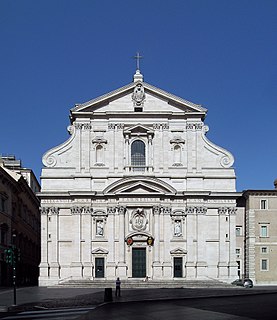
Marcantonio Franceschini was an Italian painter of the Baroque period, active mostly in his native Bologna. He was the father and teacher of Giacomo Franceschini.

The Palazzo Pallavicini-Rospigliosi is a palace in Rome, Italy. It was built by the Borghese family on the Quirinal Hill; its footprint occupies the site where the ruins of the baths of Constantine stood, whose remains still are part of the basement of the main building, the Casino dell'Aurora. Its first inhabitant was the famed art collector Cardinal Scipione Borghese, the nephew of Pope Paul V, who wanted to be housed near the large papal Palazzo Quirinale. The palace and garden of the Pallavicini-Rospigliosi were the product of the accumulated sites and were designed by Giorgio Vasanzio and Carlo Maderno in 1611–16. Scipione owned this site for less than a decade, 1610–16, and commissioned the construction and decoration of the casino and pergolata, facing the garden of Montecavallo. The Roman palace of this name should not be mistaken for the panoramic Villa Pallavicino on the shores of Lake Como in Lombardy.

Domenico Maria Canuti was an Italian painter of the Baroque period, active mainly in Bologna and Rome. He was a major painter of fresco decorations. His ceiling decorations showed a mix of Bolognese and Roman influences.

The Palazzo Buonaccorsi is an 18th-century aristocratic palace, now the civic museum of the town, located on Via Don Minzoni 24 in the historic center of Macerata, region of Marche, Italy.
Giuseppe Antonio Torri was an Italian architect of the early 18th century. He was born and died in Bologna, where he was active in a late-Baroque style.

The original Palazzo Bentivoglio was a palace in Bologna, destroyed by the mob in 1507. A second palace by the same name was built nearby, and is still standing.
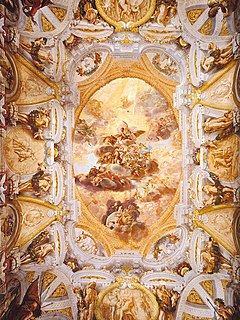
The Palazzo Pepoli Campogrande, also known as Palazzo Pepoli Nuovo, is a Baroque style palace on Via Castiglione 7 in central Bologna, region of Emilia-Romagna, Italy. In 2015, it served as a public art gallery for late-Baroque art. Across the Via, rises the medieval Palazzo Pepoli Vecchio, also once pertaining to the same family, which now serves as a museum of the history of Bologna.
The Palazzo Ranuzzi, also called Palazzo Baciocchi, is a Baroque style palace in central Bologna. It is now houses the Court of Appeals of Bologna.
The Palazzo di Residenza della Cassa di Risparmio di Bologna is a 19th-century palace, erected as Neo-Renaissance architecture, located on Via Farini #22, Bologna, region of Emilia-Romagna, Italy. It was built and is still the headquarter of the Cassa di Risparmio in Bologna.
The Palazzo Albergati is a Renaissance style palace located on via Saragozza 26-28 in central Bologna, Italy.
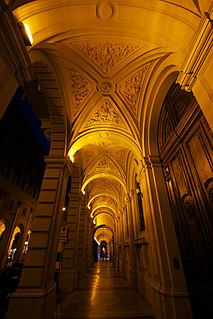
The Palazzo Legnani Pizzardi, also known as Palazzo Pizzardi e Volta or just Palazzo Pizzardi, is a Renaissance style palace located on Via d'Azeglio #38, corner with Via Farini, in central Bologna, Italy. In 2015, the palace housed the Tribunal of Bologna.
Palazzo Zani is a Renaissance palace on via Santo Stefano 56 in central Bologna, region of Emilia Romagna, Italy.
The Palazzo Marescotti Brazzetti is a Baroque style palace located on Via Barberia 4 in central Bologna, Italy. It is owned by the University of Bologna, and part of the Department of Music and Performance arts.
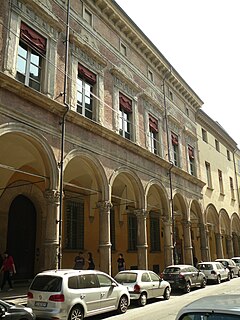
The Palazzo Bonasoni is a Renaissance-style palace in Via Galliera 21 in central Bologna, Italy. It stands across the street from the Palazzo Felicini.

Palazzo Malvezzi Campeggi is a Renaissance palace located on Via Zamboni number 22, at the corner (southwest) with Via Marsala, in central Bologna, region of Emilia Romagna, Italy. It stands across from San Giacomo Maggiore, and just northeast of the Palazzo Magnani. It presently houses the Law Faculty of the University of Bologna.
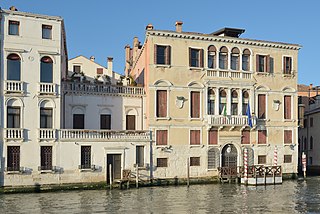
The Palazzo Gussoni Grimani Della Vida, also called Grimani a San Fosca is a Renaissance-style palace on the Grand Canal, located between the Palazetto Barbarigo and the Rio di Noale, in the sestiere of Cannaregio, in Venice, Italy.
The Palazzo Belloni is a palace located on Via de' Gombruti #13 in central Bologna, region of Emilia-Romagna, Italy.

The Palazzo Malvezzi de' Medici is a Renaissance-style palace located on Via Zamboni #13 in central Bologna, Italy. The palace now houses the offices of the Provincial Administration.
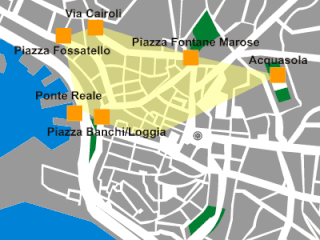
Maddalena is a neighbourhood in the old town of the Italian city of Genoa. It was one of the six sestieri of ancient Genoa. At present it is part of the Genoa's city Municipio I.

The Civic Museum of Palazzo Mosca is the main civic museum of Pesaro, displaying art and decorative works, located in Piazza Mosca in this town of the region of the Marche, Italy.

